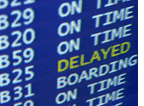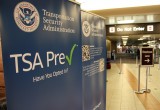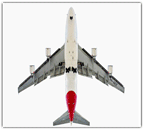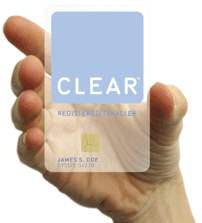Registered Traveler program expedites airport screening with biometrics and smart cards
30 January, 2005
category: Biometrics, Government, Library
 By Andy Williams, Contributing Editor
By Andy Williams, Contributing Editor
For more than six months, some 10,000 registered travelers have been able to move through airports a little faster with lanes dedicated just for them and the assurance they won’t be targeted for secondary screening. And with a final report due out this spring more airports may be allowed to offer the program.
The Registered Traveler Program of the Transportation Security Administration was supposed to last just 180 days. But the pilot that got under way at five airports last summer is still going on today.
“It has been continued indefinitely at those five airports,” said TSA spokesperson Deirdre O’Sullivan. “We’ll continue to collect data to determine the program’s effectiveness.”
The pilots are part of the U.S. Department of Homeland Security’s overall efforts to improve U.S. security. The TSA was rolled into DHS when the latter was created following 9-11. The pilot programs were launched last summer at the following locations:
- Continental Airlines at George Bush Intercontinental, Houston, Texas;
- Northwest Airlines at Minneapolis/St. Paul International;
- United Airlines at Los Angeles International;
- American Airlines at Ronald Reagan Washington National, Washington, D.C.; and
- American Airlines at Boston Logan, Boston, Mass.
“We’ll be analyzing data and will be issuing a report sometime this spring,” said Ms. O’Sullivan. “We’re talking to customers, airlines, TSA federal security directors to determine the success of the technology; and various other aspects such as costs and benefits.”
One of the decisions to be made following the release of the report is whether to expand the program at more airports. Initial indications suggest that TSA will do just that.
Bryan Ichikawa, identification solutions architect, Unisys Corp., which is running the Registered Traveler Program at three airports (Minneapolis, Los Angeles, and Houston) said, “everyone has been very happy with it.” EDS, Herndon, Virginia, was awarded the contract for Boston and Reagan. The Unisys contract was worth $2.47 million and the EDS contract $1.31 million, according to TSA.
Speaking at a recent Smart Card Alliance conference, Mr. Ichikawa said of the program’s extension, “the people who have it (Registered Traveler credentials) want to keep using it.”
When Registered Traveler was originally offered to 10,000 volunteers (2,000 per airport), Ms. O’Sullivan called the response overwhelming.
Mr. Ichikawa concurs noting, “when Minneapolis opened at 5 a.m., we had people lined up to get one.” Unisys used a “kiosk-based solution” to sign up the people.
To become a registered traveler, the volunteers had to provide a fingerprint and an iris scan, said Ms. O’Sullivan, along with basic personal information, such as name, address, etc. “TSA performed a security assessment and then advised them if they had passed,” said Ms. O’Sullivan. That security check included a review of law enforcement and intelligence data sources for outstanding criminal warrants.
Different airports, different approaches
“At Minneapolis, they were not issued a card, but some airports did issue IDs. The reason was to test the various technologies,” she added.
Ms. Sullivan says smart cards were issued at Houston and Boston. France-based Axalto supplied smart cards to Unisys for use in the Houston pilot. These cards are encoded with the travelers’ biometric identifiers that were then read at the airport security checkpoints. According to Axalto, it also delivered the software needed to interface these cards to the screening systems. The credential management system captures and encodes the biometric data – fingerprints and iris patterns.
Ms. O’Sullivan said travelers got an identifying card at Los Angeles, but it doesn’t contain a biometric data.
According to TSA, participating airports and airlines were chosen based on a several factors, including suitability of airport facilities, number of frequent travelers and level of interest in the Registered Traveler Pilot Program.
“At Minneapolis, when you arrive at the airport, you go directly to the security checkpoint and give them your fingerprint. Passengers who are part of the program still have to go through a metal detector, but they are not selected for secondary screening,” she said.
Some airports just used iris scanning, others just fingerprints. Again, the purpose was to test alternate scenarios and technologies. “Some people liked having a card. We wanted to see the benefit of the card and the cost associated with it,” she said. “At many airports, they had a designated lane (for Registered Traveler participants) and again, they didn’t have to worry about secondary screening.”
TSA, she added, “worked with both airports and airlines. We wanted to make the program accommodating as possible. On the whole feedback has been very positive.”
The one drawback, if it can be called that, is that the registered travelers can only use the biometric equipment located in the travelers’ home airports. In other words, on return trips, the traveler has to go through check-in procedures like everyone else.
Going International with Registered Traveller
The Registered Traveler Program may go international as well. DHS recently announced a pilot for immigration processing of pre-screened, international travelers through John F. Kennedy International in New York City. According to DHS, it plans to work with the Dutch Minister of Immigration and Integration to develop an international registered traveler program.
The U.S.-Dutch pilot “will bring the extensive experience the Dutch government has had with expedited travel security initiatives together with U.S. efforts, paving the way toward a truly international registered traveler program that enhances security for all travelers,” said then DHS Secretary Tom Ridge in early January.
One difference between this program and the TSA-run Registered Traveler is that participants aren’t immune from secondary screening. Those in this program will use dedicated kiosks when they arrive at JFK Airport. They will enter the United States without routine Customs and Border Protection (CBP) questioning, unless chosen for a selective or random secondary referral. They must present their machine-readable passport, submit their fingerprints for biometric verification, be photographed, and make a declaration at the kiosk. Once cleared at the kiosk, pilot participants will be allowed to claim their bags and exit the airport.
The future of Registered Traveller
Based on the informal responses from early participants in the Registered Traveler program and the actions and comments of officials at DHS and TSA, it seems likely that the program has a solid future. In the coming months the official project report will be issued and information from the International trial will be emerging. For many frequent travelers, any effort they can take to expedite airport security processing is considered a worthwhile investment.
To learn more about the Registered Traveler program, visit TSA on the web by clicking here.




